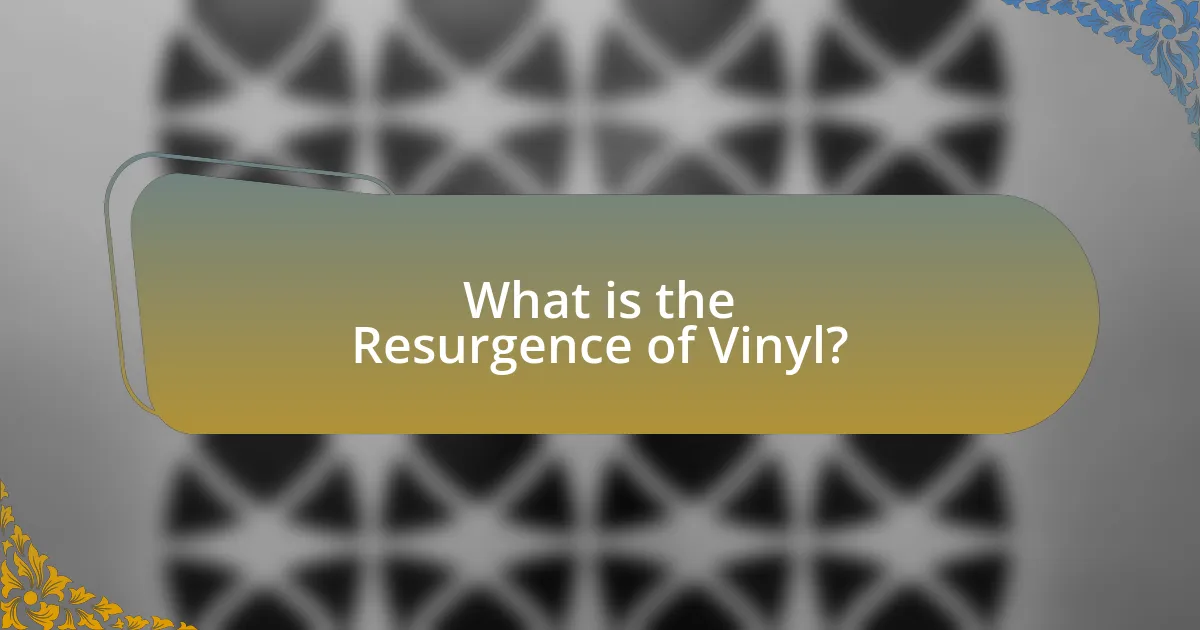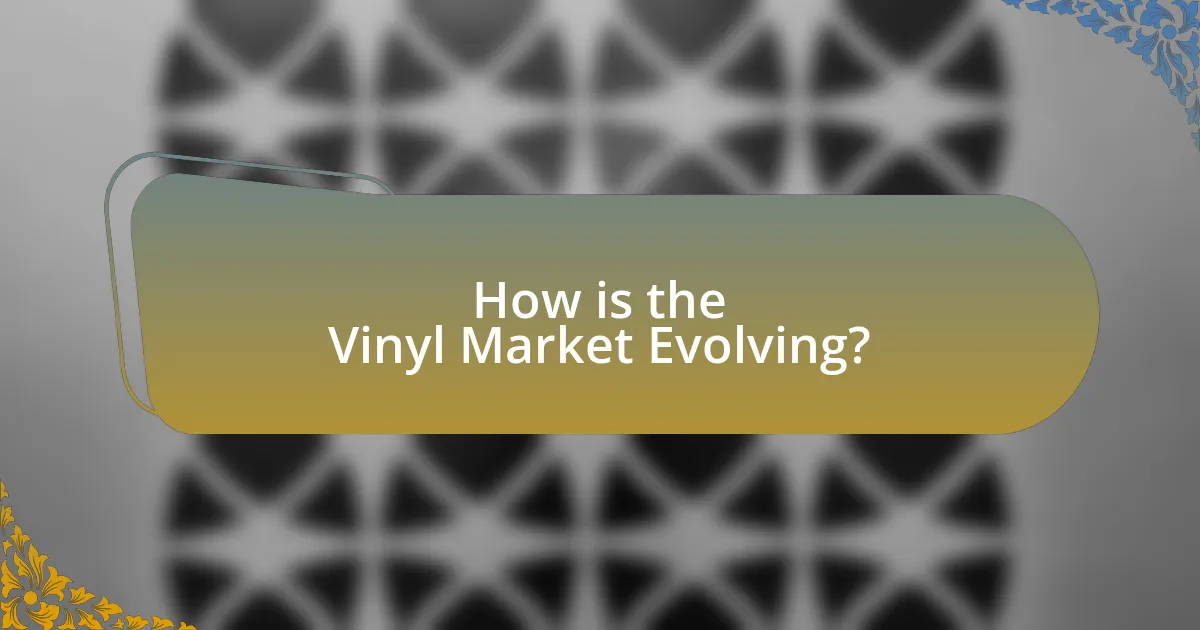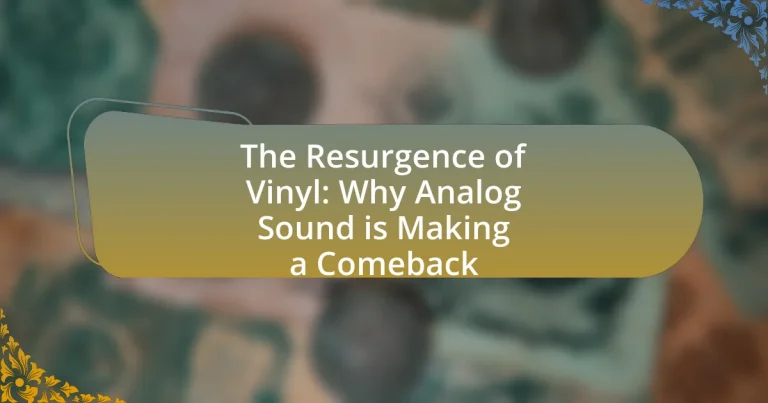The resurgence of vinyl refers to the significant revival of vinyl records, marked by a notable increase in sales since the early 2000s, culminating in 2020 when vinyl sales in the United States surpassed CD sales for the first time since the 1980s. This trend is driven by factors such as a growing appreciation for analog sound quality, the tactile experience of physical media, and nostalgia for past musical eras. The article explores the cultural factors contributing to vinyl’s popularity, the evolving market dynamics, the role of collectors and enthusiasts, and the challenges faced by the vinyl industry today. Additionally, it discusses how technology and innovations in manufacturing may shape the future of vinyl records, as well as practical tips for enhancing the vinyl listening experience.

What is the Resurgence of Vinyl?
The resurgence of vinyl refers to the significant revival in the popularity of vinyl records, which has been observed since the early 2000s. This trend is characterized by increasing sales figures; for instance, in 2020, vinyl sales in the United States surpassed CD sales for the first time since the 1980s, with over 27.5 million vinyl records sold. Factors contributing to this resurgence include a growing appreciation for analog sound quality, the tactile experience of physical media, and the appeal of album artwork. Additionally, many artists and labels are now releasing new music on vinyl, further fueling consumer interest and engagement in this format.
Why is vinyl experiencing a revival in today’s music industry?
Vinyl is experiencing a revival in today’s music industry primarily due to its unique sound quality and the tangible experience it offers. Many audiophiles and casual listeners alike appreciate the warm, rich tones that vinyl records provide, which are often perceived as superior to digital formats. According to the Recording Industry Association of America (RIAA), vinyl sales reached a 30-year high in 2020, surpassing CD sales for the first time since the 1980s, indicating a significant shift in consumer preference. Additionally, the physical nature of vinyl records, including album artwork and the ritual of playing a record, creates a nostalgic and immersive experience that digital formats cannot replicate. This combination of sound quality and the tactile experience contributes to the ongoing resurgence of vinyl in the music industry.
What cultural factors are contributing to the popularity of vinyl records?
The popularity of vinyl records is primarily driven by a cultural appreciation for nostalgia and authenticity. Many consumers are drawn to vinyl as it evokes memories of past eras, particularly the 1960s and 1970s, when vinyl was the dominant format for music consumption. This nostalgia is reinforced by the tactile experience of handling records and the larger album artwork, which contrasts with the digital music experience. Additionally, the resurgence of vinyl is supported by a growing trend towards analog experiences in a digital age, where people seek authenticity and a deeper connection to music. According to the Recording Industry Association of America (RIAA), vinyl sales reached a 30-year high in 2020, indicating a significant cultural shift towards valuing physical music formats over digital ones.
How has the perception of vinyl changed over the years?
The perception of vinyl has shifted from being viewed as outdated and obsolete to being celebrated as a premium format for music enjoyment. In the late 20th century, with the rise of digital formats like CDs and MP3s, vinyl records were largely considered relics of the past. However, since the early 2000s, there has been a significant resurgence in vinyl sales, with figures from the Recording Industry Association of America indicating that vinyl sales reached a 30-year high in 2020, surpassing CD sales for the first time since the 1980s. This change reflects a growing appreciation for the tactile experience, sound quality, and nostalgia associated with vinyl records, leading to a cultural revival that embraces analog sound as a distinct and valued medium.
What are the characteristics of vinyl that appeal to listeners?
Vinyl records appeal to listeners primarily due to their warm sound quality, tactile experience, and nostalgic value. The analog nature of vinyl produces a rich, full-bodied sound that many enthusiasts believe captures the nuances of music better than digital formats. Additionally, the physical act of handling records, including the ritual of placing a needle on the groove, enhances the listening experience. Nostalgia plays a significant role as well; many listeners associate vinyl with a bygone era, evoking memories and emotions tied to the music of that time. These characteristics contribute to the growing popularity of vinyl in an increasingly digital world.
How does analog sound differ from digital formats?
Analog sound differs from digital formats primarily in the way sound is captured and reproduced. Analog sound captures continuous waveforms, representing sound in a physical medium, such as vinyl records or magnetic tape, which allows for a more natural and warm sound quality. In contrast, digital formats convert sound into discrete samples, typically using a process called pulse-code modulation, which can lead to a loss of some audio nuances due to quantization and compression. Studies have shown that many listeners perceive analog recordings as richer and more immersive, partly due to the harmonic distortion and noise inherent in analog systems, which can enhance the listening experience.
What unique qualities do vinyl records offer in terms of sound quality?
Vinyl records offer a unique sound quality characterized by warmth, depth, and a rich tonal range. This distinct auditory experience arises from the analog nature of vinyl, which captures sound waves in a continuous format, preserving the nuances of the original recording. Unlike digital formats that can compress audio and potentially lose detail, vinyl maintains a broader frequency response and dynamic range, allowing listeners to experience music as it was intended by the artists. Studies have shown that many audiophiles prefer the sound of vinyl due to its ability to reproduce low frequencies and harmonics more naturally, contributing to a more immersive listening experience.
What role do collectors and enthusiasts play in the vinyl resurgence?
Collectors and enthusiasts play a crucial role in the vinyl resurgence by driving demand and influencing market trends. Their passion for collecting vinyl records fosters a community that values analog sound quality and the tangible experience of music. According to the Recording Industry Association of America (RIAA), vinyl sales reached 41 million units in 2020, marking the highest level since 1986, largely fueled by collectors who seek both classic and new releases. This demographic not only purchases records but also shares their knowledge and enthusiasm through social media and events, further promoting vinyl culture and encouraging new listeners to explore the format.
How has the collector community influenced vinyl sales?
The collector community has significantly influenced vinyl sales by driving demand for both new releases and reissues. This community actively seeks out rare and limited-edition records, which has led to a resurgence in vinyl production; for instance, in 2020, vinyl sales in the U.S. reached 27.5 million units, the highest level since 1991, largely fueled by collectors. Additionally, the collector community often engages in social media and online forums, sharing information about releases and fostering a culture of appreciation for analog sound, which further stimulates interest and sales in the vinyl market.
What are the motivations behind vinyl collecting?
The motivations behind vinyl collecting include a deep appreciation for analog sound quality, nostalgia for past musical experiences, and the tangible nature of vinyl records. Collectors often cite the warmth and richness of analog audio as superior to digital formats, which is supported by studies indicating that vinyl can provide a more immersive listening experience. Additionally, many collectors are driven by nostalgia, as vinyl records evoke memories of earlier decades and cultural moments. The physicality of vinyl, including album artwork and the act of handling records, enhances the overall experience, making it more personal and engaging compared to digital music.

How is the Vinyl Market Evolving?
The vinyl market is evolving through a significant resurgence in popularity, driven by a growing consumer preference for analog sound quality and tangible music experiences. In 2022, vinyl sales in the United States surpassed CD sales for the first time since the 1980s, with vinyl records accounting for 41 million units sold, according to the Recording Industry Association of America (RIAA). This shift indicates a strong demand for physical formats, as collectors and new listeners alike seek the unique auditory experience that vinyl provides. Additionally, the expansion of independent record labels and the rise of vinyl pressing plants have facilitated increased production, further supporting the market’s growth.
What trends are shaping the current vinyl market?
The current vinyl market is shaped by several key trends, including a growing consumer interest in analog sound, increased sales of new vinyl releases, and a rise in vinyl pressing plants. The resurgence of vinyl is driven by a desire for tangible music formats and the unique sound quality associated with analog recordings. According to the Recording Industry Association of America (RIAA), vinyl sales reached 41 million units in 2022, marking the highest level since the 1980s. Additionally, the number of vinyl pressing plants has increased significantly, with over 30 new facilities opening in the past few years to meet the rising demand. This combination of consumer interest and production capacity is solidifying vinyl’s place in the music industry.
How are new artists adapting to the vinyl format?
New artists are adapting to the vinyl format by incorporating it into their marketing strategies and production processes. Many emerging musicians are recognizing the unique appeal of vinyl, which offers a tangible product that enhances the listening experience. For instance, artists are releasing limited edition vinyl records that feature exclusive artwork and bonus tracks, appealing to collectors and fans. Additionally, the resurgence of vinyl sales, which reached 41 million units in 2022 according to the Recording Industry Association of America, indicates a growing market that new artists can tap into. This trend encourages artists to invest in vinyl production as a way to differentiate themselves in a crowded digital landscape.
What impact does vinyl have on album sales compared to digital formats?
Vinyl records significantly boost album sales compared to digital formats. In 2022, vinyl sales in the United States reached 41 million units, surpassing CD sales for the first time since the 1980s, according to the Recording Industry Association of America (RIAA). This resurgence indicates that consumers are increasingly valuing the tangible and nostalgic aspects of vinyl, which contrasts with the convenience of digital formats. The unique sound quality and collectible nature of vinyl records contribute to their appeal, driving higher sales figures in the physical music market.
What challenges does the vinyl industry face today?
The vinyl industry faces significant challenges today, including supply chain disruptions, rising production costs, and competition from digital formats. Supply chain disruptions have been exacerbated by global events, leading to delays in obtaining raw materials necessary for vinyl production. Rising production costs, particularly for vinyl pellets and labor, have impacted profit margins for manufacturers. Additionally, the competition from digital music platforms continues to pose a threat, as consumers increasingly favor the convenience of streaming services over physical media. These factors collectively hinder the growth potential of the vinyl industry despite its resurgence in popularity.
How does production capacity affect the availability of vinyl records?
Production capacity directly influences the availability of vinyl records by determining how many records can be manufactured within a specific timeframe. When production capacity is limited, it results in fewer records being pressed, leading to shortages in the market. For instance, during the vinyl resurgence in the 2010s, many pressing plants faced overwhelming demand but struggled with outdated equipment and limited workforce, which restricted their output. This situation caused delays in releases and increased prices due to scarcity, illustrating the critical link between production capacity and vinyl record availability.
What environmental concerns are associated with vinyl production?
Vinyl production raises significant environmental concerns primarily due to the use of polyvinyl chloride (PVC), which is a petroleum-based plastic. The production process of PVC involves the release of harmful chemicals, including dioxins, which are known to be toxic and can accumulate in the environment. Additionally, the manufacturing of vinyl records generates substantial waste and energy consumption, contributing to carbon emissions. According to a study by the European Commission, the lifecycle of PVC, from production to disposal, poses risks to both human health and ecosystems, highlighting the need for more sustainable practices in the vinyl industry.

What are the Future Prospects for Vinyl?
The future prospects for vinyl are promising, with a continued increase in sales and interest among consumers. In 2022, vinyl sales in the United States surpassed 41 million units, marking the highest level since the 1980s, according to the Recording Industry Association of America (RIAA). This resurgence is driven by a growing appreciation for analog sound quality, collectible packaging, and the nostalgic value associated with vinyl records. Additionally, the expansion of vinyl pressing plants and the introduction of new titles by both established and emerging artists indicate a sustained commitment to the medium. As long as these trends continue, vinyl is likely to maintain its relevance in the music industry.
How might technology influence the future of vinyl records?
Technology will likely enhance the production, distribution, and listening experience of vinyl records in the future. Innovations such as advanced manufacturing techniques can improve sound quality and reduce production costs, making vinyl more accessible. Additionally, digital technology can facilitate the integration of vinyl with modern audio systems, allowing for seamless playback alongside digital formats. For instance, companies are developing turntables with Bluetooth capabilities, enabling users to connect to wireless speakers while maintaining the analog charm of vinyl. This fusion of technology and tradition supports the growing interest in vinyl, evidenced by a 2022 report from the Recording Industry Association of America, which noted that vinyl sales surpassed CD sales for the first time since the 1980s, highlighting a significant shift in consumer preferences driven by technological advancements.
What innovations are being introduced in vinyl manufacturing?
Innovations in vinyl manufacturing include the development of eco-friendly materials, advanced pressing techniques, and improved sound quality technologies. Eco-friendly materials, such as recycled PVC and plant-based alternatives, reduce environmental impact while maintaining product integrity. Advanced pressing techniques, like precision temperature control and automated quality checks, enhance production efficiency and consistency. Additionally, innovations in sound quality, such as the use of higher-quality mastering processes and the introduction of digital technology in vinyl production, have led to a richer listening experience. These advancements reflect the industry’s response to consumer demand for sustainable and high-fidelity audio products.
How could streaming services impact vinyl’s popularity moving forward?
Streaming services could enhance vinyl’s popularity by fostering a renewed interest in music and artists, leading consumers to seek physical formats for a more tangible experience. As streaming platforms provide easy access to vast music libraries, they often introduce listeners to a wider range of genres and artists, which can drive demand for vinyl records as collectors’ items. According to the Recording Industry Association of America (RIAA), vinyl sales reached 41 million units in 2020, the highest level since 1986, indicating a strong market for physical formats. This trend suggests that as streaming services continue to promote music discovery, they may simultaneously encourage consumers to purchase vinyl records for their aesthetic and auditory qualities.
What practical tips can enhance the vinyl listening experience?
To enhance the vinyl listening experience, ensure proper setup and maintenance of your turntable. A level turntable minimizes distortion and tracking errors, while a clean stylus prevents dust buildup that can degrade sound quality. Additionally, using high-quality speakers and amplifiers can significantly improve audio fidelity, as they accurately reproduce the nuances of vinyl recordings. Research indicates that vinyl records can provide a warmer sound due to their analog nature, which many listeners prefer over digital formats. Regularly cleaning records with a carbon fiber brush removes surface dust, further enhancing playback clarity.
How should vinyl records be properly cared for and maintained?
Vinyl records should be properly cared for and maintained by cleaning them regularly, storing them vertically, and handling them by the edges. Regular cleaning with a carbon fiber brush removes dust and debris, preventing scratches and preserving sound quality. Storing records vertically prevents warping and damage, while handling them by the edges minimizes the transfer of oils and dirt from fingers. These practices are essential for maintaining the integrity and longevity of vinyl records, as improper care can lead to degradation in sound quality and physical damage.
What equipment is essential for an optimal vinyl setup?
An optimal vinyl setup requires a turntable, a phono preamp, speakers, and quality vinyl records. The turntable is essential for playing the records, while the phono preamp amplifies the signal from the turntable to a level suitable for speakers. Quality speakers are necessary to accurately reproduce the sound, and high-quality vinyl records ensure the best audio fidelity. According to a 2021 report by the Recording Industry Association of America, vinyl sales reached their highest level since 1986, highlighting the growing interest in quality analog sound and the importance of having the right equipment for an optimal listening experience.


